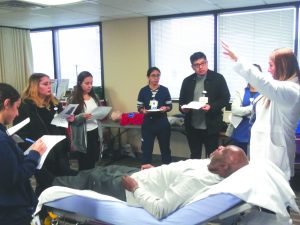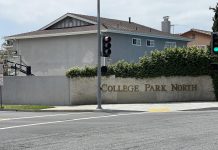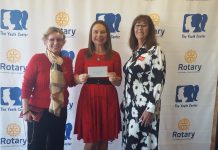
By David N. Young
Approximately 25 fresh faced registered nurses gathered with instructors and recovering stroke patients this past Thursday seeking certification from the National Institutes of Health Stroke Scale, which instructors from Los Alamitos Medical Center are authorized to issue.
Officials say the stroke training for registered nurses are offered once a quarter and this was the last training session of 2018.
After an introductory classroom session, two instructors from the Los Alamitos Medical Center, Heidi Taylor, program manager, and Nurse Practitioner Melissa Radcliff split the class in two and gathered around stroke patients who have made substantial recoveries from stokes.
With half of the RN’s gathered around, Taylor grabs former patient Bryan Murray’s arm and asks him to raise it. Then, she holds her hand near his face and asks, “what do you see?” The students listen intently as she goes through a check list of physical and motor skill tests that are crucial to determining the extent suffered by incoming stroke patients.
Taylor then shows students how to check everything from eyebrows down the toes, asking Murray to elevate his leg at a 45-degree angle, advising them that “a little bounce is okay.”
The LAMC Program Manger instructs them on how to interpret reactions and how to factor in the age of the patient.
Taylor also instructs the students how to quickly determine palsy (temporary or permanent paralysis) and to access the extent to which a stroke patient has been affected.
Across the way, Radcliff raises does similar tests with her recovering stroke patient, Ron Wingard, then asks her students to step in and do the same.
“When a stroke patient comes into this facility,” she says to the nurses, “this is the worst day of their lives. Your job is first to connect and provide compassion,” she says to the students.
 Radcliff emphasizes to the RN’s to remember that stroke patients are people, “loved by their family” and in addition to providing excellent care, nurses are told to deliver the care with “professionalism and courtesy.”
Radcliff emphasizes to the RN’s to remember that stroke patients are people, “loved by their family” and in addition to providing excellent care, nurses are told to deliver the care with “professionalism and courtesy.”
Then she flips the script and asks one of the students to jump in. They do. “How are you,” asks Vanessa Villa.“ Then Villa grabs his leg and asks, “does this feel okay?” Another nurse, Angel Martinez, steps up and asks Wingard to extend his hand and hold it.
Once they complete the course, these nurses will be certified to administer what the National Institute of Health calls the “Stroke Scale,” a regimented series of tests that provide doctors and other medical professionals with immediately health intelligence that will allow them to expedite and administer care to arrest the spread of the stroke to prevent further damage.
There are multiple types of strokes. A stroke may be caused by a blocked artery (ischemic stroke) or the leaking or bursting of a blood vessel (hemorrhagic stroke). Some people may experience only a temporary disruption of blood flow to the brain (transient ischemic attack, or TIA) that doesn’t cause permanent damage, and the knowledge gained by this training allow nurses to provide specialized care.
Because of the large volume of stokes in the area (two to three per day), the Los Al Medical Center has become recognized as a CSC (Comprehensive Stroke Center).
Taylor and her staff provide four training sessions per year as registered nurses become the front line for incoming stroke patients.
Once treated, the stroke patients then have access to significant rehabilitation services, as she tells them after the fact that Murray’s ability to raise his leg and function are a testament to why they are becoming certified.
“This patient was told he would never walk again,” she said and “look at him.”
“I like being the dummy” joked Wingard, as he sat up on the stretcher following the demonstration. He suffered a stroke in 2008 and said it was totally scared. He was told he would never walk or drive. “I was in a bad place,” he said.
Yet with compassionate care, he now gets around fine, though not perfect, and he has reclaimed his driver’s license. I come here to give back to those who gave so much to me,” he said.











